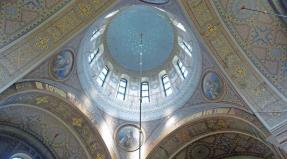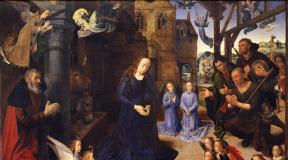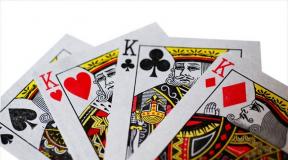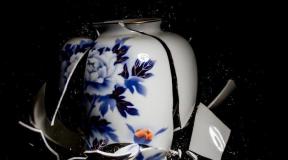Jesus Christ walked on water. The taming of the storm and the walk of jesus christ on the waters
Mt. XIV, 22-34: 22 And immediately Jesus compelled His disciples to get into the boat and go before Him to the other side, while He sent the people away. 23 And having sent the people away, He went up the mountain to pray alone; and in the evening he remained there alone. 24 And the boat was already in the middle of the sea, and it was beating with waves, because the wind was contrary. 25 On the fourth watch of the night Jesus went to them, walking on the sea. 26 And the disciples, seeing him walking on the sea, were alarmed and said: This is a ghost; and they cried out in fear. 27 But Jesus immediately spoke to them and said, Be of good cheer; it is I, do not be afraid. 28 Peter answered and said to him: Lord! if it is you, command me to come to you on the water. 29 He said, Go. And, getting out of the boat, Peter walked on the water to come up to Jesus, 30 but seeing the strong wind, he was frightened and, starting to drown, cried out: Lord! save me. 31 Jesus immediately stretched out his hand, supported him, and said to him: Little faith! why did you doubt? 32 And when they got into the boat, the wind ceased. 33 And those who were in the boat came up, bowed down to him, and said, Truly you are the Son of God. 34 And they crossed over and arrived in the land of Gennesaret.
Mk. VI, 45-53: 45 And immediately he compelled His disciples to get into the boat and go ahead to the other side to Bethsaida, while He sent the people away. 46 And having sent them away, he went up the mountain to pray. 47 In the evening the boat was in the middle of the sea, and He is alone on the ground. 48 And he saw them troubled on the voyage, because the wind was against them; about the fourth watch of the night he approached them, walking on the sea, and wanted to pass them. 49 When they saw Him walking on the sea, they thought it was a ghost, and cried out. 50 For they all saw Him and were afraid. And immediately he spoke to them and said to them: be of good cheer; it is I, do not be afraid. 51 And he went into the boat with them, and the wind ceased. And they were exceedingly amazed at themselves and marveled, 52 for they did not understand miraculously over the loaves, because their hearts were petrified. 53 And, having crossed, arrived in the land of Gennesaret and landed to shore.
Jn. VI, 15-21: 15 But Jesus, knowing that they wanted to come, unwittingly take him and make him king, again withdrew to the mountain alone. 16 And when evening came, His disciples went down to the sea 17 and, getting into a boat, went to the other side of the sea, to Capernaum. It was getting dark and Jesus did not come to them. 18 A strong wind was blowing, and the sea was agitated. 19 When they sailed about twenty-five or thirty stadia, they saw Jesus walking on the sea and approaching the boat, and they were afraid. 20 But he said to them: I am; do not be afraid. 21 They wanted to take Him into the boat; and immediately the boat landed on the shore where they were sailing.
Study Guide to the Four Gospels
Prot. Seraphim Slobodskoy (1912-1971)
Based on the book "The Law of God", 1957.
Jesus Christ Walking on Water
After miraculously feeding the people with five loaves of bread, Jesus Christ ordered His disciples to go by boat to the other side of the Lake of Galilee, to Bethsaida of Galilee. He himself, having dismissed the people, went up the mountain to pray.
The night has come. The boat with the students was already in the middle of the lake, and it was beating with waves because there was a strong headwind.
Before dawn, Jesus Christ, knowing the calamity of the disciples, went to them on the water. When they saw Him walking on the water, they thought it was a ghost, and screamed out of fear.
But Jesus Christ immediately spoke to them: "Calm yourself, it is I, do not be afraid."
Then the apostle Peter exclaimed: “Lord! if it is You, then command me to come to You on the water. "
The Lord said, "go."
Peter got out of the boat and walked on the water to come to Jesus Christ. But, seeing a strong wind and big waves, he was frightened, faith disappeared from fear, and then he began to sink and shouted: “Lord! save me".
Jesus Christ immediately stretched out His hand to him, supported him and said: “you have little faith! why did you doubt? " And when they got into the boat, the wind died down.
The disciples came up, bowed to Jesus Christ and said: "Truly you are the Son of God."
Archbishop. Averky (Taushev) (1906-1976)
A Guide to Studying the New Testament Scriptures. Four Gospels. Holy Trinity Monastery, Jordanville, 1954.
28. The Lord's Walking on Waters and Healing Many Sick
(Matt. XIV, 22-36; Mark VI, 45-56; John VI, 16-21)
Urged by the Lord to go to the western side of Lake Gennesaret, the disciples got into the boat and sailed away. Darkness fell (John v. 17), a contrary wind was blowing, the boat was in the middle of the lake, it was beating with waves (Matt. V. 24), and the Lord was not with them. He was left alone on earth, but he saw their distress (Mark v. 48). They were twenty-five or thirty stadia from the east bank (John v. 19). It was about the fourth watch, i.e. by the morning dawn. And suddenly they saw Jesus walking towards them along the sea, but, nevertheless, as if wishing to pass them (Mark).
Seeing Him walking on the water, they thought it was a ghost, and screamed out of fear, but the Lord calmed them with the words: "Dare, I am: do not be afraid!" With a passionate temperament, Ap. Peter was inflamed with a desire to go to meet the Lord and asked for a command to do so, to which the Lord answered him: "Go!" Peter got out of the boat, and the power of his faith performed a miracle: he walked on the water. But the wind, which continued to rage and strong waves, distracted Peter's attention from Jesus, to Whom he was walking, under the influence of the fear that gripped him, his faith wavered, and he began to sink, in despair he cried out: "Lord, save me!" The Lord immediately stretched out his hand to support him and said: "Little faith, why have you doubted?" About this walk of Ap. Peter is transmitted by water only one Ev. Matthew (vv. 28-31).
As soon as they entered the boat, the wind instantly died down, and the boat quickly landed on the shore where they were sailing. All those in the boat approached then, bowed to Him and said: "Truly, the Son of God is!" As soon as Jesus came ashore, he was immediately surrounded by the inhabitants of that place: they recognized Him, hastened to inform all the surrounding villages of this and brought all the sick to Him. The belief in the miraculous power that emanated from Him was so strong that the inhabitants of the place where He landed, only asked permission for the sick to touch His clothes, and those who touched were healed.
A. V. Ivanov (1837-1912)
A Guide to Studying the New Testament Scriptures. Four Gospels. SPb., 1914.
Walking of Jesus Christ on the waters and arrival in the land of Genesaret
(Matt. 14: 22-36; Mark 6: 45-56; John 6: 15-21)
Those who saw the miraculous multiplication of the loaves wanted to make Jesus, against His will, king; but Jesus retired to the mountain in solitude and stayed there in prayer, and ordered the disciples to go to the other side of the lake in the evening. For almost a whole night, the students struggled with waves and headwinds and barely reached the middle of the lake. Jesus Christ, on the fourth watch of the night - that is, already before the morning - seeing them in distress at sea, went to them on the sea and, approaching the boat, showed a form that he wanted to pass them; but they, taking Him for a ghost, were frightened and began to scream. Jesus reassured them and by His presence so encouraged them that always and in everything the zealous Peter asked for himself permission to walk to Him on the water and really went to Him; but, fearing the strong wind, he began to plunge into the water and drown. After reproaching Peter for his lack of faith and stretching out his hand, Jesus entered the boat with him and calmed the storm. Those in the boat bowed to Him and confessed Him to be the Son of God. Then the boat suddenly came to the shore. The inhabitants of the region of Gennesaret hastened to take advantage of His presence and brought their sick to Him, whom He healed.
1. One cannot think about the walking of Jesus Christ that it was walking on a ford in shallow water, even if it was even near the coast - the Apostle Peter drowned in the very place where Jesus Christ walked on water. Yes, and one cannot assume such a walk, just because Jesus Christ during the night crossed the entire Lake of Galilee, through which it was possible to swim only in a boat.
2. The disciples saw their Teacher on the 4th watch of the night. Thus shared the night with the Romans in the army; The Jews have adopted this division since the time of Pompey, subjecting them to Roman rule. Among the ancient Jews, according to the testimony of Jewish writers, the night was divided only into three guards, that is, three shifts of guards.
3. Mark and John do not mention the walk of the Apostle Peter on the water, probably because they wanted mainly to draw the attention of their readers to the face and actions of Jesus Christ Himself. Moreover, it is known that the Evangelist Mark, who wrote under the leadership of the Apostle Peter, at his request, omits other details about him, as the Church Fathers say. The Apostle John, rereading the Gospels of the first Evangelists and supplementing them, did not want to break the pious sense of modesty of his brother and also did not mention Peter's walking on the waters.
4. The sea of \u200b\u200blife, raised by the misfortune of a storm, often shakes with doubts the closest disciples of the Savior; but in the deepest night of misfortunes, the Lord, who is eternally vigilant over everyone, comes to the soul to encourage it and call it to Himself; and if there are not many Petrov who dare to walk on the waters of doubt to their Teacher, then in any case, in a moment of danger, not one drowning in waves of doubt and crying for salvation will not be left without help. Such will soon be led to a quiet haven and a confession in the truth, as Jesus is the Son of God.
5. A ship in the middle of the blazing sea is the image of the Church, overwhelmed by waves of misfortune in the midst of the world. Jesus is the quiet haven of all those who are overwhelmed. Peter walking on the waters is the image of believers.
There are questions that are pointless to ask a work of fiction: for example, why Gandalf made Frodo take a not very pleasant walk, instead of taking him on an eagle and dropping him off at the very mountain, or why Proust wrote everything he wrote at all. These questions speak of a poverty of mind and a poverty of imagination. It's like asking a stone - why is it here. Lies and lies, we will not touch him.
By its very recumbent presence, it creates the feeling that it is an integral part of the landscape, but if you paint it, say, bright yellow or fuchsia, then it will be striking. And it will start again - who? as? why? and for what? Artificial interference will lead to exactly those questions that are ridiculous in the art world.
But they also create the excitement that, if properly presented, helps to turn the work into a profitable project, and this feature has long been learned to use. In the most successful cases, everyone is satisfied - the creator, the producer (sometimes the same person) and the audience.
Ivan_Albright
In 1945, Hollywood director Albert Lewin announced a film competition for his new film, The Private Life of a Dear Friend, an adaptation of Maupassant's novel. The novel features "a picture of the Hungarian artist Karl Markovich, depicting Christ walking on the waters", and made a lot of noise.

Paul_Delvaux
Lewin, who graduated from Harvard and came to Hollywood from the University of Missouri, where he taught English literature, seems to have seen his mission in popularizing the great literature of the 19th century. His previous film, The Picture of Dorian Gray, naturally revolved around the picture - and then he tried the trick he returned to while filming Dear Friend. He commissioned a portrait of Dorian Gray to Ivan Albright, and at the climax of the film, which was otherwise entirely black and white, produced a single color shot showing the painting in close-up.

Eugene_Berman
In the same way, now, faced with the need to use a certain conventional work of art in the props, he decided to repeat his find, making it something like his own trademark. However, this time, apparently, other considerations were mixed with this. Perhaps realizing that the film turns out to be rather boring (this is a good film adaptation, but nothing more), the director, who served as a producer for a long time under the supervision of such a prototype producer as Irving Thalberg, was not averse to attracting additional public attention to the film with the help of a small advertising campaign. and the special kind of excitement that avant-garde paintings on religious themes always raise. On the other hand, he sincerely loved contemporary art and, most likely, hoped to simultaneously provide material assistance to artists whom he especially appreciated and respected.

Leonora_Carrington
Be that as it may, the idea was implemented on a grand scale. However, first of all, it was necessary to make changes to the plot of the picture, since the good old American censorship - o tempora! o mores! - did not allow the "physical" image of Christ on the screen. Lewin even benefited from this prohibition, because he knew that the subject of walking on water was not the most attractive for artists. Therefore, he chose The Temptation of St. Anthony.
Lewin himself selected the contestants. Invitations were sent to twelve artists. Some of them were first-class European craftsmen who emigrated to the United States due to Nazi persecution. They were Ivan Albright, Eugene Berman, Leonor Finney, Paul Delvaux, Horace Pippin, Stanley Spencer, Max Ernst, Leonora Carrington, Louis Guillelmi, Salvador Dali, Dorothea Tanning and Abraham Rattner.

Abraham_Rattner
In the end, eleven artists submitted the paintings - all except Leonor Finney, who did not make it on time. Each participant was entitled to $ 500 per painting, and the winner was to receive $ 2,500. The winner was determined by an independent jury of three experts who awarded the main prize to Max Ernst. With the proceeds, the artist bought a piece of land in Sedona, Arizona, near the Hopi reservation.

Salvador_Dali
To promote the film, it was agreed in advance that a tour of America and Europe would be organized for the films. The scandal, so necessary to stir up interest in contemporary art, from the very beginning was provided by the mayor of Boston, who banned the exhibition of paintings in his city, considering them "religiously and morally offensive." The organizers filed a lawsuit, mutual claims followed, but in the end the case died out by itself.

Horace_Pippin
This is an amazing story in which everyone was pleased. Albert Lewin drew attention to his film, helped several artists (many of whom were in difficult financial situations), and once again acted as an educator, introducing the American public to contemporary art.
The artists received a lot of money for those times. Max Ernst won the competition; however, his wife Dorothea Tanning shared the victory. Salvador Dali, although formally lost, created one of his most popular paintings. The Boston Mayor and film critics seized the opportunity to declare their highly moral and artistically correct position.

Stanley_Spencer
All the paintings were sold to museums and private collections; one - Louis Guillelmi - was lost ("whereabouts unknown"). For one and only time in 1981, nine "Temptations" again appeared in the same hall - at the Cologne exhibition "Westkunst".

Dorothea_Tanning
Meanwhile, this plot itself is a gift for a semioticist. Several rows of oppositions are built here, several levels of reflection are involved, transitions between several mediums are played out. The painting "The Temptation of St. Anthony" as a real object was written for the film - the adaptation of a literary work. Naturally, in the film, the picture is no longer a picture, but another reflection of itself. The combination of artistic, visual, cinematic and literary reflections of fictional reality creates a real nesting doll of realities, in which plans are superimposed on each other in such a way that ultimately the sequence of reflections ceases to have any meaning, turning into a matryoshka labyrinth. The saint is tempted on a multiplied scale: in a novel (not Maupassant, of course, but Flaubert, but, of course, almost all artists were guided by Flaubert in interpreting the plot), in a film, in eleven paintings, and from this his feat plays with new colors.

Max_Ernst
P.S. And an elegant appendage: when this text was already written, news feeds reported that art critic Gergely Barki, while looking through Stuart Little with his daughter, found in one of the scenes a painting by Robert Bereny hanging behind the heroes' backs “A Sleeping Woman with a Black vase ”, which was considered lost since the late 1920s. May the spirit of Christmas be with us.
The episode referred to in this reading - Christ's walking on water - is unique in its own way. About him is told in three Gospels: from Matthew, Mark and John, only Luke is silent about this event. On the other hand, all four Gospels describe an episode that immediately precedes the walking on waters, namely, what we heard about in church last week, the feeding of five thousand people with five loaves of bread. This is important because in order to better understand the meaning of today's reading, one should first outline the general context: where and when the described event occurs. Then we will understand what it meant for the participants in these events, for the apostles, in particular - for the Apostle Peter, and also - what does it mean for us today?
So, comparing different Gospels, we can conclude that this event took place during the celebration of the Jewish Passover, in the spring of the third year of the Lord's earthly ministry, that is, a year before the Passion of Christ. This is a special time for the Lord. The Evangelist Matthew in the same 14th chapter tells about the killing of John the Baptist by Herod. The public ministry of the Lord, the Galilean period, during which Christ preaches, works miracles, gathers disciples and selects the closest apostles from among them, is drawing to a close. This period ends with the great miracle of feeding five thousand people with five loaves of bread and two fish - Christ will not perform more such large-scale miracles.
At the same time, a difficult situation develops around Christ: Herod, hearing the rumor about Jesus, remembers the slain John and believes that Christ is the risen Baptist. Apparently, some kind of oppression begins: it is not for nothing that in the subsequent chapters the Evangelist Matthew tells that Jesus and his disciples go to the borders of Tire and Sidon, that is, he leaves the domain of Herod. The relationship between the Lord and the elite of Jewish society - the scribes and Pharisees - is becoming more and more tense.
So, on the one hand, Christ is surrounded by the closest disciples-apostles, on the other hand, his opponents are activated. Herod persecutes Him, the Pharisees, scribes and Sadducees are increasingly dissatisfied with His activities.
And against this background, at first, the miracle of feeding five thousand takes place, and on the same night - walking on the waters of the Sea of \u200b\u200bGalilee.
These events take place in Galilee, near the city of Capernaum. Evangelist Matthew and Evangelist Mark do not say why the Lord sent the disciples apart from Himself in a boat, why they had to leave at all. But the Evangelist John explains: the people, impressed by the miracle of feeding the five thousand, wanted to “come, unintentionally take Him and make Him king” (John 6.15). The Gospels go on to say that the crowds watched the disciples' boat, hoping to see Jesus Christ. This is apparently why the Lord sends His disciples separately.
So, after the miracle of feeding five thousand loaves of bread, something happened that Christ warned about at the very beginning of His ministry. Satan in the wilderness, tempting Him, offered to take stones and make bread out of them. Like, do it - and people will follow you, you will become an earthly king. But the Lord did not come to accept earthly authority. And this is what people want: they saw that this preacher can feed them, and they want to make Him king. That is why Christ takes refuge. He avoids the people, first goes alone to the mountain to pray, and sends the disciples to the other side of the Sea of \u200b\u200bGalilee ahead of Himself.
On the night the disciples set out on their journey without Christ, a storm broke out on the Sea of \u200b\u200bGalilee. Judging by the words of the evangelist, the storm lasted most of the night - we can draw such a conclusion by reading the words about the fourth watch, during which the disciples saw Christ walking on the waves. At this time in Palestine, the day was divided in the same way as in Rome. For example, the night was divided into four guards. This means that the students fought the waves for three quarters of the night - three guards - and at the same time were able to swim quite a bit: only 25-30 stages (one stage - about 180 meters).
And now, when the disciples were already exhausted in the midst of the waves, they saw Christ walking on the raging lake. Why is the Lord doing this? To understand this, let's look at the reaction of the apostles. The apostle Peter is the first to respond, which is not surprising: it is not the first and not the last time that Peter acts as “the mouth of the apostles,” speaking for everyone. This is because of Peter's character: impetuous, hot, zealous.
It is Peter who rushes to Christ and strives to walk to Him even on the waves. And here we can compare this episode with a passage from the Gospel of Luke about the miraculous catch, when, according to the word of Christ, the future apostles take out nets full of fish from the water, although before that they had been a failure all night. The Apostle Peter then, seeing this miracle, said on behalf of everyone: Get out from me, Lord, for I am a sinful man. Then Peter still knew little of Christ, but his heart felt that before him was not just a man, but a messenger from God. Then Peter was frightened.
In the present reading, Peter's reaction is different. Peter has long been with Christ, is one of His closest apostles, saw many miracles, heard sermons. And here Peter behaves differently than in the situation of a miraculous catch - he himself asks to go to Christ: "Lord, if it is You, command me to come to You on the water!" (Mt 14:28). Christ says to him: go.
And then an event occurs that perfectly characterizes the Apostle Peter. He follows his impulse to go to Christ, to be with God, but humanly - he is afraid. And at some point, fear takes over and Peter begins to drown.
Here is a very interesting commentary by St. John Chrysostom to this passage: "It is useless to be with Christ for those who do not come to Him by faith." Almost three years have passed since the apostles are with the Lord, they already know that their Teacher is a special person, sent from God, but fear continues to live in their hearts. The Gospel does not idealize the apostles, but shows them as real people. Even during the Last Supper, a few hours before the Passion, they argue among themselves: which of them will be in the most honorable place in the kingdom of the coming Messiah.
Fears and doubts will remain in the disciples until the event of Pentecost, when the fire of the Holy Spirit burns up their human passions and weaknesses, turning the apostles into pillars of faith.
So in today's reading we see a vivid combination of faith and unbelief, doubt in the heart of the apostles. This doubt almost destroys Peter, he almost drowned, frightened by the waves, but Jesus saves him and together they enter the boat. And immediately the storm subsides. And the disciples, seeing all this, confess Jesus: “Truly you are the Son of God” (Matt 14:33).
On the one hand, this is a strong confession. On the other hand, one should not see in him the final heartfelt acceptance of the apostles that Jesus is the true God. In this case, "Son of God" does not mean confessing Christ as the hypostasis of the Holy Trinity, as we Christians are accustomed to believe. This is just a designation of a righteous person, a holy person who pleases God and has, therefore, special miraculous gifts.
But after two chapters of the Gospel of Matthew, in response to Christ's question, "Whom do you say I am?" (Mt 16. 13) the Apostle Peter, again speaking on behalf of all the disciples, will say: You are Christ, the Son of the Living God (M 16. 16). And this will already be a confession of the messianic dignity of Jesus, higher than in today's episode.
Nevertheless, today's confession means a lot. Mark the Evangelist notes with bitterness that the apostles were not impressed by the miracle of feeding the five thousand (Mk. 6:52). And, apparently, by the miracle of walking on water, Christ teaches His disciples another divine lesson. This lesson became a new step for the disciples on the path of true confession of Jesus of Nazareth as the Messiah, Christ, Son of God, Savior.
Note also that this is not the first episode when Jesus subdues the water element with a single wave. He had already fallen into a storm at sea with his students and tamed him with one single word. The Gospel tells us about several of Jesus' miracles over natural nature: turning water into wine, drying up a fig tree, pacifying a storm. In such episodes, Christ appears before us as the ruler of the universe, the one who has the power to rule the world.
Today's reading can be interpreted in a broader context, if we talk not only about him, but in conjunction with the episode that precedes walking on water. Bishop Kassian (Bezobrazov) connects walking on water with the miracle of the multiplication of loaves and says that here symbolically Christ appears as Moses who led Israel across the sea. Jesus walks on the waters - and the apostles follow Him.
We can say that Jesus ends the Galilean period of His ministry with the miracle of walking on waters, which was typified in the Old Testament by the salvation of Israel from the persecutor-Pharaoh and the transition to a new life in the promised land. By this, He seems to be telling His disciples that those who follow Him will make the transition from death to life, from not knowing God to knowing God.
Gospel of Matthew (14: 22-34)
“And immediately Jesus compelled His disciples to get into the boat and go before Him to the other side, while He sent the people away. And, having sent the people away, He went up the mountain to pray in private; and in the evening he remained there alone. And the boat was already in the middle of the sea, and it was beating with waves, because the wind was nasty. On the fourth watch of the night Jesus went to them, walking on the sea. And the disciples, seeing Him walking on the sea, were alarmed and said: This is a ghost; and they cried out in fear. But Jesus immediately spoke to them and said: be of good cheer; it is I, do not be afraid. Peter answered and said to him: Lord! if it is you, command me to come to you on the water. He said: go. And, getting out of the boat, Peter walked on the water to come up to Jesus, but seeing the strong wind, he was frightened and, starting to drown, cried out: Lord! save me. Jesus immediately stretched out his hand, supported him and said to him: you have little faith! why did you doubt? And when they got into the boat, the wind died down. But those who were in the boat came up, bowed down to Him and said: Truly you are the Son of God. And, having crossed, arrived in the land of Gennesaret.
Vladyka Pavel addressed the readers of Vesti with a sermon that day
On the ninth week (Sunday) after Pentecost, the Holy Church once again reminds that the Lord, being the Creator of the Universe, conquers not only human pain and suffering, not only designs hostile to evil spirits against man, not only multiplies little and gives abundance. He conquers death with his glorious Resurrection and, being the King of Heaven and Earth, He conquers the elements in the Universe, establishing order.
On this day, the rector of the Kiev-Pechersk Lavra, Metropolitan of Vyshgorod and Chernobyl Vladyka Pavel addressed the readers of Vesti with a sermon.
Walking on Waters: Gospel
"Walking on Waters". Ivan Aivazovsky
And immediately Jesus compelled His disciples to get into the boat and go before Him to the other side, while He sent the people away.
And, having sent the people away, He went up the mountain to pray in private; and in the evening he remained there alone.
And the boat was already in the middle of the sea, and it was beating with waves, because the wind was nasty. On the fourth watch of the night Jesus went to them, walking on the sea. And the disciples, seeing Him walking on the sea, were alarmed and said: This is a ghost; and they cried out in fear. But Jesus immediately spoke to them and said: be of good cheer; it is I, do not be afraid.
Peter answered and said to him: Lord! if it is you, command me to come to you on the water. He said: go. And, getting out of the boat, Peter walked on the water to come up to Jesus, but seeing the strong wind, he was frightened and, starting to drown, cried out: Lord! save me. Jesus immediately stretched out his hand, supported him and said to him: you have little faith! why did you doubt?
And when they got into the boat, the wind died down. But those who were in the boat came up, bowed down to Him and said: Truly you are the Son of God. And, having crossed, arrived in the land of Gennesaret.
Matt, 59 credits, 14, 22-34
Walking on Waters Sermon

"Walking on Waters". Alexander Ivanov
"Let's analyze the current Gospel reading. So, in order to reveal a new miracle, the Lord asks His disciples without Him to get into the boat and go to the other side, let the people go and go up the mountain to pray alone. All the actions of the Savior in every passage of the Gospel are given to us for edification. and help us find our way to salvation.In solitude, it is easier for a person to see God, that is, throwing away everything worldly and fussy, immerse himself in prayer and conversation with the Lord.Letting the people, the Savior seems to be freed from everything connected with the earthly world in order to ascend in a higher prayer to His Creator, "explained Metropolitan Paul.
He noted that usually in the world people, feeling complete loneliness, fall into despondency, despair, and this feeling of uselessness sometimes leads to very disastrous consequences. Trying to forget and forget, a person finds "consolation" in alcohol, drugs - and often this ends in suicide, and this is a terrible sin.
"All this happens when a person does not find God. But for a prayer book, prayer and loneliness are the opening of a new, better world where the light of Christ shines. And if you recall the previous Gospel reading, then before the multiplication of the loaves, the Lord prayedAnd now, before the miracle of walking on the waves, the Lord also turns to the Creator in prayer.
Thus, the Lord shows us that every good deed must begin with a prayer to God.
But prayer is beneficial when we want to do a good deed and ask the Lord for help. It is impossible to do evil - and call on the help of God. We must also remember that everything that happens in our life happens according to God's will or God's permission for our admonition, "Vladyka Paul emphasized.
“But the Lord, foreseeing this, wanted the disciples to feel this powerlessness when He was not around, in order to thereby contribute to the strengthening of their faith. It was a kind of test of faith. But one who has strong faith in the Lord cannot perish! The Savior again clearly shows us that we should not fall into despair, even in the most hopeless situation. The Lord knows and sees all human weaknesses, sufferings and situations in which a person finds himself. Christ is not always in a hurry to help us, strengthening us in faith, but He sees everything ", - the abbot of the monastery assured.
This is how we think that the Lord has left, and He is even closer in difficult times, only we do not see Him.
When the Lord approaches us, we not only do not recognize Him, but we are also afraid of His approach, and fear settles in a person so much that he begins to fear everything. And this is a sign that the devil is already settling in our heart and begins to guide us through our weaknesses, lack of faith, doubt ... "
And so, when the disciples had already despaired of salvation, they saw Christ walking on the waves, as on the earth. In the beginning there was fear, because what he saw defied human logic and explanation. They saw the miracles of the Lord and had to guess about the power of the Lord, but being still spiritually immature, they showed little faith, and that only did not occur to them at that hour. But the Lord always tests those he loves. For it is said, "... The Lord punishes him whom he loves; but he beats every son he accepts" (Hebrews 12: 6). And if we recall the earthly life of Christ Himself, then enduring the greatest suffering, torment, reproach, an unrighteous trial, crucifixion - He conquers death and Resurrects.

The book "Dear Friend" by Guy de Maupassant describes the paintings of Karl Markovich "Jesus Walking on the Waters"the prototype of which was the painting "Christ before Pilate" (1881) by the artist Mihai Munkacci.
All the martyrs also endured suffering for the faith of Christ, and the torment was terrible. But they remained faithful to Christ to the end and received help from the Lord, because the Savior does not allow anyone to suffer more than a person can withstand, Metropolitan Paul emphasized.
And the apostles who were in fear suddenly heard a familiar voice and recognized Christ, who addressed them: "Take courage, it is I, do not be afraid!" He knew about their fear, despair and was in a hurry to come to their aid. These words are often heard by the righteous who suffer for Christ.
Peter walks on water: sermon
"And now we see the great joy of Peter, who in exultation also wants to come up to Jesus on the water. But a grain of doubt is added to the joy. And even though Peter asks the Lord for a command to come to Him, the Lord answers:" Go "- here is that little a share of doubt and lack of faith gave rise to fear, and Peter begins to drown.That is, while he walked with faith, left and forgot everything worldly and earthly, his soul was somewhat separated from his body and was with the Lord, he walked confidently on such a dangerous path, he walked towards Christ It must be said that steadfastness and strength in faith is achieved, of course, not immediately, but through realizing, understanding God and accepting Him as your Savior, "Vladyka Paul explained.
And Peter, realizing that he is drowning, turns to the Lord: "Lord, save me." And Christ, stretching out his hand, says: "Little faithful! Why did you doubt?"
"But the Lord could stop the wind with one word, and He stretches out His hand to Peter. Why? Christ wants to strengthen faith in Peter. But each of us can remember a case from his life when the same invisible hand helped in the most hopeless situation. But not everyone can realize that it was the hand of the Lord! And when we realize the presence of our Lord all the days of our life, then we, being on earth, with our mind, heart, thought, will be in the world where the Savior reigns. And we must remember that no one and nothing can defeat Christ and will never win. Only the Lord conquers all evil and opens the way for us to the Kingdom of Heaven, where there are no sorrows, no sicknesses, no sighs, but there is endless life, "Metropolitan Paul emphasized.
Which sea did Jesus walk

Kinneret - the lake where Jesus walked on water
In conclusion, we note that many lay people are interested in the question: "On which sea did Jesus walk?" or want to know what this "lake where Jesus walked on water" is.
To begin with, let's clarify that we are talking about the lake, not the sea. And it is called the Kinneret. In the New Testament, it is referred to as the Sea of \u200b\u200bGalilee, Tiberias, or Genesaret. However, due to its size - 30 by 8 kilometers - scientists attribute this reservoir to lakes. On the one hand, the Jordan River flows into it, and on the other it flows out.
It was here that the future apostles Andrew and Peter fished. And Jesus walked on it like on dry land. On the shores of the same lake, He appeared to the apostles after the resurrection.
Earlier, "Vesti" wrote aboutwhy is a pig a dirty animal in religion... This was stated in the sermon of Vladyka Paul for the 21st week after Pentecost.
We also reported that what kind of fish did Jesus feed 5000 people... This was mentioned in the sermon of Vladyka Paul on the 8th week after Pentecost.



















